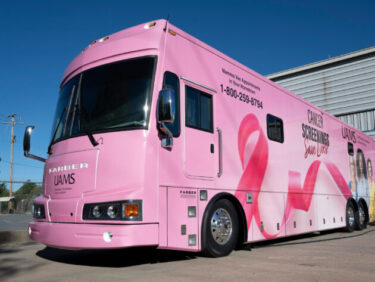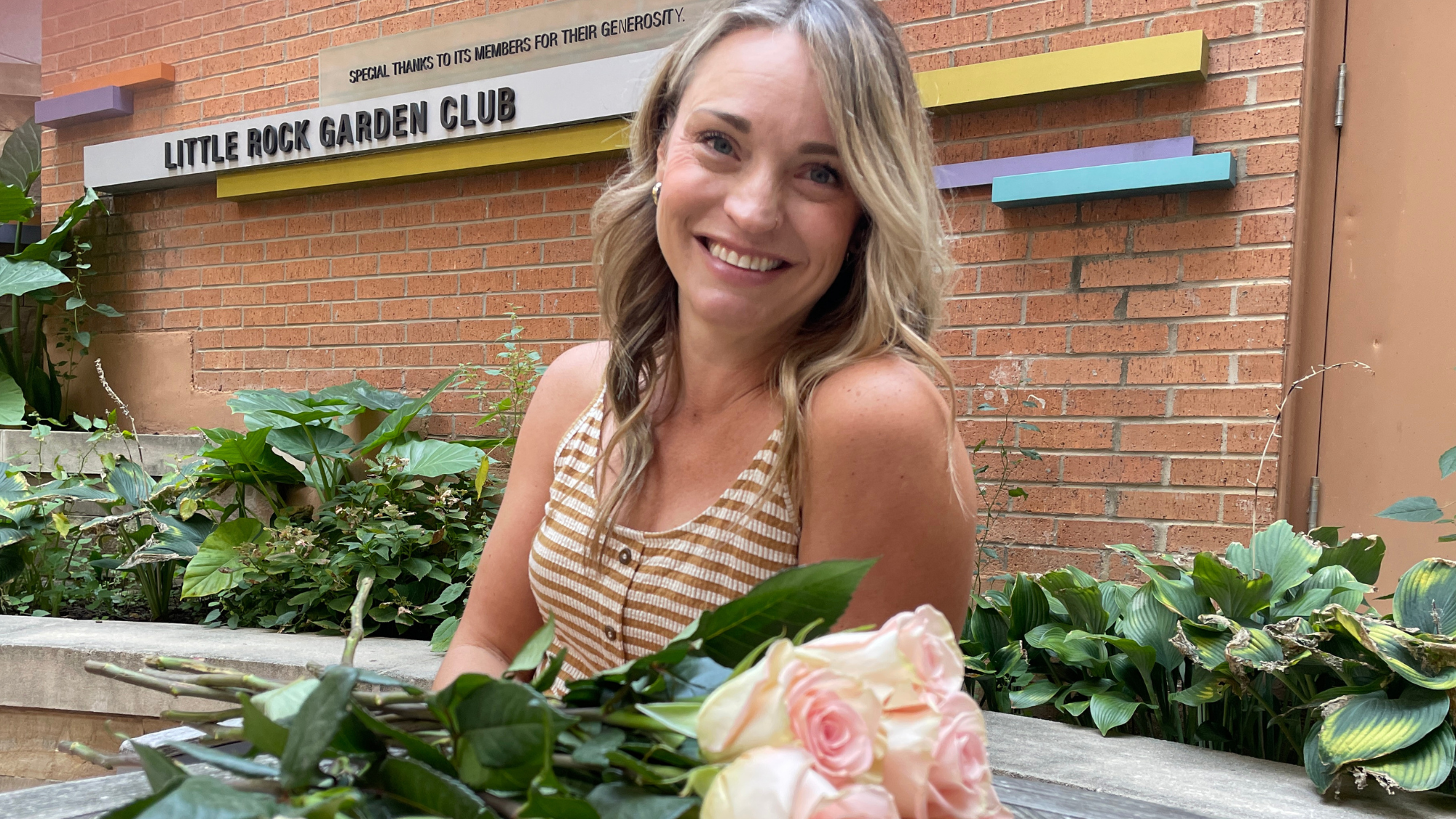Just in Time: Genoa Mom Grateful for Lifesaving Visit from UAMS MammoVan
| A 45-foot van in the parking lot of your child’s elementary school might seem an unlikely location for one of the most important medical exams of your life. It was ideal for Lyndee Braley.
The busy mother of three from tiny Genoa, Arkansas, population 972, had just turned 40 when she saw a notice on the school district’s message board that the UAMS MammoVan was coming to town.
“Genoa is so small. I was so surprised they came here,” said Braley. But Genoa and rural communities like it are exactly where the MammoVan wants to be.
Located in Miller County, Genoa sits in one of 28 Arkansas counties that lack an FDA-approved mammography facility. To fill the gap, the UAMS MammoVan travels the state — more than 300,000 miles so far — to small, rural areas to provide screening mammograms for breast cancer.
A 14-year partnership of the UAMS Health Breast Center at the Winthrop P. Rockefeller Cancer Institute’s Breast Center and the Arkansas Department of Health, the MammoVan has screened more than 35,000 Arkansas women for breast cancer, diagnosed more than 150 women with the disease and navigated them to lifesaving follow-up care.
 “The MammoVan has played a large role in addressing breast cancer health disparities,” said UAMS Breast Center Director and Division Chief of Breast Imaging Gwendolyn Bryant-Smith, M.D. “Many patients will not participate in screening mammograms because of socioeconomic barriers, transportation, ability to take off work or finances. The MammoVan meets them where they are.”
“The MammoVan has played a large role in addressing breast cancer health disparities,” said UAMS Breast Center Director and Division Chief of Breast Imaging Gwendolyn Bryant-Smith, M.D. “Many patients will not participate in screening mammograms because of socioeconomic barriers, transportation, ability to take off work or finances. The MammoVan meets them where they are.”
On April 4, Braley had her very first mammogram on the MammoVan, along with 13 other women from Genoa and nearby communities. About 15% of the MammoVan’s patients are first-timers and the other 85% are return patients, coming back to the MammoVan year after year for their annual screenings.
UAMS Breast Technologist Heather Kindy knows many of the women served by the MammoVan by name. She’s been in the driver’s seat for most of the van’s travels across Arkansas. She does everything from scheduling patients and conducting the mammograms themselves to filling the gas tank and keeping the van’s extra-large windshield clean.
“I love being on the road and out in the community with the van. I get to meet so many amazing women. It’s an honor,” said Kindy, who is known to greet patients with a warm southern, “Hi, how are you?”
The feeling is mutual. “I loved her,” Braley said of Kindy. “She was like a friend. She helped me so much.”
“I fear that more women would skip screenings or not get them as often as they need them if we weren’t there,” said Kindy. “The need for this mobile outreach is real.”
“Without the MammoVan, I still may not have had a mammogram,” Braley admits. “I really might still be putting it off today. It was the most convenient thing ever.”
The 3D mammogram Braley received on the MammoVan that fateful day set in motion the timely medical care and intervention that saved her life.
Because the van is equipped with 3D Digital Breast Tomosynthesis, Braley received the highest standard mammogram available, the very same she would have gotten had she traveled the 150 miles to the UAMS Health Breast Center at the Winthrop P. Rockefeller Cancer Institute in Little Rock.
As soon as the MammoVan returns to Little Rock each day, patient images are uploaded to the UAMS campus system and ready for review the next day by UAMS Breast Center radiologists, including Bryant-Smith, the center’s director.
By the afternoon of April 5, the day after Braley’s exam, Bryant-Smith interpreted the mammogram exam as abnormal. Kindy then arranged for Braley to have a diagnostic mammogram to work up the screening abnormality at the UAMS Breast Center. During this visit, Rachel Taylor, M.D evaluated Braley’s case and recommended and performed a biopsy on her suspicious right breast microcalcifications.
The MammoVan Team moved quickly to coordinate with the UAMS Breast Center to get Braley on the schedule, a patient navigation service the team offers to all patients.
“The minute we see an abnormal mammogram, the clock is ticking,” said Bryant-Smith. “Getting a patient to a permanent breast center quickly, whether it’s here or to another facility is paramount. I’m so proud of our team and how well we work together to navigate patients to follow-up care quickly and efficiently.”
To limit Braley’s travel time to Little Rock and the Cancer Institute, the team arranged for her to have two biopsies in one day. The biopsies confirmed a diagnosis of ductal carcinoma in situ (DCIS) in the right breast and no cancer in the left. DCIS is a common, early-stage breast cancer that occurs in the milk ducts of the breasts but has few symptoms.
Following the diagnosis, Braley says everything moved fast. After meeting with Ronda Henry-Tillman, M.D., UAMS chief of breast surgical oncology, Braley chose to have a bilateral mastectomy to remove both breasts and three lymph nodes on her right breast. With a family history of breast cancer on her father’s side, the preventive surgery reduces the chance of her cancer returning. Today, she is cancer-free and recovering well from reconstructive surgery performed by UAMS’ James Yuen, M.D.
“I could not be more thankful. I loved my team at UAMS,” Braley said.
The MammoVan will make its fifth visit to Genoa in the spring of 2025. Check the MammoVan schedule to find out if the van is coming to your community.
